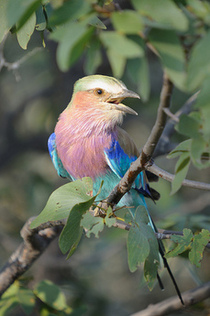Lilacbreasted Roller
The Lilac-breasted Roller, Coracias caudatus, is a member of the roller family of birds. It is widely distributed in sub-Saharan Africa and the southern Arabian Peninsula, preferring open woodland and savanna; it is largely absent from treeless places. Usually found alone or in pairs, it perches conspicuously at the tops of trees, poles or other high vantage points from where it can spot insects, lizards, scorpions, snails, small birds and rodents moving about at ground level. Nesting takes place in a natural hole in a tree where a clutch of 2–4 eggs is laid, and incubated by both parents, who are extremely aggressive in defence of their nest, taking on raptors and other birds. During the breeding season the male will rise to great heights, descending in swoops and dives, while uttering harsh, discordant cries. The sexes are alike in colouration. Juveniles do not have the long tail feathers.
The Lilacbreasted Roller is classified as Least Concern. Does not qualify for a more at risk category. Widespread and abundant taxa are included in this category.
Lilacbreasted Roller (Coracias caudasta) photographed at Kasane, Botswana. The Afrikaans name for this bird, Troupant, means a wedding band and legend has it that its feathers have been used by Zulu tribal chiefs as wedding bands. More
The lilacbreasted Roller is a large sized bird usually solitary or in pairs. Perches on top of bushes and trees to watch for insects. It swoops to the ground to catch prey. Feeds on insects, lizards, small snakes, birds and rodents. Common in savanna and open woodland. Nests in a hole in a tree. bird pictures Sunset pictures Pictures of reptiles Stock Photography of Lilacbreasted roller is available from www.stock-photography.co.za. More
The Lilacbreasted Roller (Coracias caudata) is a common resident in large parts of the Southern African region including Zimbabwe, Zambia, Botswana, Namibia, Mozambique and parts of South Africa. They are found in a variety of woodland types and will usually be seen hawking for insects from a favoured position in a tall tree, telephone pole or similar vantage point. They tend to be quite noisy when carrying out their characteristic aerobatic display. More
- A Lilacbreasted Roller trows its catch, a grasshopper, in the air to get it in position to swallow. - Image of A Lilacbreasted Roller trows its catch, a grasshopper, in the air to get it in position to swallow. Creator: Chris Kruger License: Royalty Free (RF) Model Release: NO Size: 0.71 MB Print size: 4.7" x 3. More
I took this photograph of the Lilacbreasted Roller in the Mahango Game Reserve in Namibia's Kaprivi Strip. It is one of my favourite African birds, mainly because of its spectacular colours. It is also very prevalent in the African bush, and occurs over great rantges. Its distinctive feature is the lilac coloured breast, from there the name. Mahango Game Reserve is a small reserve which is well-known for its high concentrations of Sable and Roan antelope. More

Original source: Gavin Goodhart
Author: Gavin Goodhart
Permission: Some rights reserved
Family : Coraciidae
Genus : Coracias
Species : caudatus
Authority : Linnaeus, 1766

